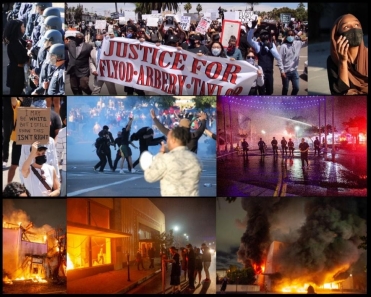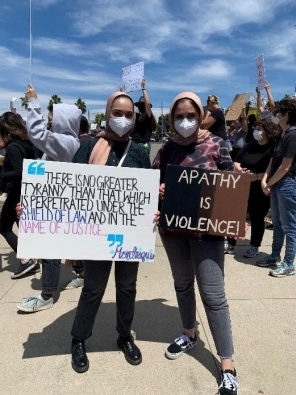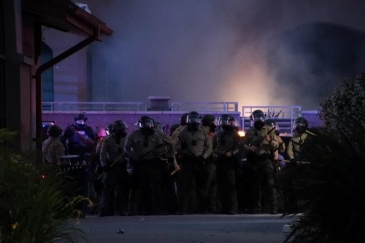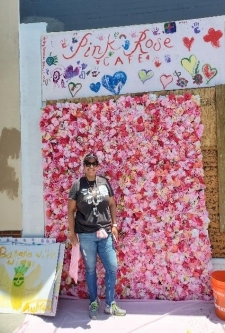
By Miriam Raftery
Photos by ECM photojournalists Henri Migala, Jake Rose, Miriam Raftery, Paul Kruze and Rebecca Jefferis Williamson
June 5, 2021 (La Mesa) – A racial justice protest on May 30, 2020 erupted into a tense standoff at the La Mesa Police station followed by a night of looting, vandalism, and the burning down of three buildings in La Mesa’s historic downtown district. The events shocked and terrifed the community.
What began as a peaceful protest focused on the killing of George Floyd by a white police officer in Minneapolis, but also on a controversial stop by a La Mesa Police officer of Amaurie Johnson, a young Black man. two days before the protest and riot. A bystander's video of the Johnson incident went viral and was widely viewed as racial profiling, sparking anger. The ensuing chaos resulted in multiple injuries to protesters and widespread property damage.
One year later, however, the city has made strides toward accountability, healing racial rifts, police reforms, helping businesses that were harmed, and moving forward with rebuilding plans.
Mayor Mark Arapostathis called the experience “traumatic” during a private event at La Mesa First United Methodist Church to commemorate the events, adding that the city must learn from the tragedy to remember what can happen when people feel excluded.

 Assemblymember Akilah Weber M.D. (photo, left), was a La Mesa Councilmember during the turbulent events. The city's first African-American elected official recalled May 30, 2020 as a “promising day” when people turned out to stand up against the unjust killing of George Floyd in Minneapolis as well as to protest against a La Mesa Police officer’s controversial stop of Amaurie Johnson in a videotaped incident widely viewed as racial profiling.
Assemblymember Akilah Weber M.D. (photo, left), was a La Mesa Councilmember during the turbulent events. The city's first African-American elected official recalled May 30, 2020 as a “promising day” when people turned out to stand up against the unjust killing of George Floyd in Minneapolis as well as to protest against a La Mesa Police officer’s controversial stop of Amaurie Johnson in a videotaped incident widely viewed as racial profiling.
Dr. Weber recalled the event turning into a night of pain and destruction, but concluded, “We turned that pain into a new purpose. We made sure we told our story of who La Mesa is and who the residents are and who the businesses are…we will not be defined by one incident…”
Her mother, Secretary of State Shirley Weber, called love, inclusion, justice and freedom a “rare flower” that requires attention. By contrast, hatred, discrimination and neglect are a “weed” that grows best in neglect, she noted.
Some leveled criticism at the event organizers, La Mesa Conversations and Envision La Mesa, for excluding some voices. Kristine Alessio, a former La Mesa Council member, chided the La Mesa First United Methodist Church for not inviting its own members, adding, “A true day of remembrance would have been public, involved those who suffered the losses and were terrified.”
The East County Enquirer questioned why no invitations were sent to the East County Chamber of Commerce and local leaders led by El Cajon Councilman Phil Ortiz, whose successful raised over $260,000 to help businesses pay for repairs.
Remembrances and lessons learned
 Subsequent protests held in the city remained peaceful, including one staged by motorcyclists at which a photo went viral of then-Chief Walt Vasquez hugging a burly black biker.
Subsequent protests held in the city remained peaceful, including one staged by motorcyclists at which a photo went viral of then-Chief Walt Vasquez hugging a burly black biker.
One can only speculate what might have happened if protesters had been met by police or city officials when they first knocked on the police station door the afternoon of May 30, 2020.
With no response, the crowd became increasingly hostile and by evening, the police station was under siege. Rocks and bottles were hurled at officers; LMPD and Sheriff’s deputies fired tear gas, pepper spray and beanbag rounds at protesters after the crowd ignored orders to disperse when an unlawful assembly was declared. Burning Molotov cocktails were thrown at the police station, which was covered in graffiti, and multiple protesters were injured, including a woman struck in the forehead by a beanbag round.
 The violence soon escalated beyond the police station. Multiple vehicles were set on fire. A fire was ignited inside city hall, but swiftly doused. Vons at the La Mesa Springs shopping center was set afire, prompting a response from officers in riot gear. Dozens of businesses along La Mesa Blvd. and elsewhere were broken into and looted.
The violence soon escalated beyond the police station. Multiple vehicles were set on fire. A fire was ignited inside city hall, but swiftly doused. Vons at the La Mesa Springs shopping center was set afire, prompting a response from officers in riot gear. Dozens of businesses along La Mesa Blvd. and elsewhere were broken into and looted.
In the middle of the night, Union and Chase Banks were set aflame, followed by the Randall Lamb building. Mutual aid did not arrive to fight the fires, as it was deemed too dangerous for firefighters, with protesters still pelting rocks and bottles until the Sheriff took command after midnight and arrests were made in the wee hours of the morning.
 With the burned buildings still smoldering the next morning, however, over 600 people from across East County turned out to help clean up. They came armed with mops, brooms, rollers and paint buckets, as well as restaurants donating food to feed the clean up crews. These actions helped restore La Mesans’ faith in humanity and the inherent goodness of residents.
With the burned buildings still smoldering the next morning, however, over 600 people from across East County turned out to help clean up. They came armed with mops, brooms, rollers and paint buckets, as well as restaurants donating food to feed the clean up crews. These actions helped restore La Mesans’ faith in humanity and the inherent goodness of residents.
In an exclusive interview with ECM a week after the riot, La Mesa Police Chief Walt Vasquez said, “The outreach is already starting. I’ve had people reaching out to me. The police and Sheriff are already talking about this,” he promised. “As we progress through this and start that healing, those kinds of outreach and changes will happen,” he promised, “without a doubt.”
Soon after, Chief Vasquez abruptly announced his retirement. A nationwide search for a new Chief continues.
Reforms and resiliency
The city and partner law enforcement agencies have made significant changes and strides toward healing the community.
La Mesa has established a citizens police oversight board comprised of a broad spectrum of community members to investigate complaints of excessive use of force in the future. After the May 30 riot, police made efforts to coordinate with future protest organizers, and the city commissioned an independent report to find out what went wrong and what reforms could be implemented.
 Mayor Arapostathis, in an interview with ECM in the riot’s aftermath, said he was “devastated” and sorry for what happened. He pledged reforms, adding, “nothing is off the table.”
Mayor Arapostathis, in an interview with ECM in the riot’s aftermath, said he was “devastated” and sorry for what happened. He pledged reforms, adding, “nothing is off the table.”
Many reforms have occurred. The City Council commissioned an independent report on the response to the protest and riot. La Mesa Police banned chokeholds and changed police to terminate officers found to have lied. The city also held public meetings with a goal to improve communications with residents, since notifications were glaringly lacking during the long night of terror. The police department did, however, improve notifications in subsequent protests and other events, tweeting out frequent updates during ensuing tense times including National Guard troops sent to maintain peace in the city.
ensuing tense times including National Guard troops sent to maintain peace in the city.
The city of La Mesa fired LMPD officer Matt Dages, who has also been criminally charged for falsifying a police report in which he accused Johnson of assault, an assertion not backed up by multiple videos. The city did not charge Johnson, who has filed a suit against the city. Dages has also filed a lawsuit against the city seeking his position back.
Dozens of accused looters and rioters have been arrested. Most notably, Ricky Bernard Cooper and Alexander Jacob King face arson charges for burning down the Chase Bank building, according to the FBI. Daniel Sandoval of Campo was charged with arson and felony vandalism of the historic Randall Lamb building which was also burned down, according to Lieutenant Greg Runge with La Mesa Police.
But no charges have yet been filed for the burning down of Union Bank, a crime that remains unsolved.
 Union Bank recently installed a trailer with an ATM on its downtown site and has announced plans to start rebuilding this summer, with hopes to reopen by year’s end. A sign nearby reads,”All we need is love. Rebuilding together.”
Union Bank recently installed a trailer with an ATM on its downtown site and has announced plans to start rebuilding this summer, with hopes to reopen by year’s end. A sign nearby reads,”All we need is love. Rebuilding together.”
 Chase Bank, too, has indicated it plans to rebuild but its efforts are expected to take longer, since Chase does not own the land. However, the Randall Lamb site’s future remains uncertain, as the company has not announced any decision to rebuild nor any other use planned for its still-vacant lot downtown.
Chase Bank, too, has indicated it plans to rebuild but its efforts are expected to take longer, since Chase does not own the land. However, the Randall Lamb site’s future remains uncertain, as the company has not announced any decision to rebuild nor any other use planned for its still-vacant lot downtown.
In the aftermath of the riot, artists turned out to paint murals on plywood boarding up windows in the downtown village. The Pink Rose Café, stymied from opening by the riot and pandemic, adorned its façade with a wall of pink roses. This spring, the Pink Rose Café finally attained its dream of opening,  a symbol of resilience.
a symbol of resilience.
Scars and accountability questions remain
The riot left emotional scars on residents, business owners, protesters, police officers and reporters who covered the protest and riot. San Diego Union-Tribune reporter Karen Pearlman posted at the time, “The smell of tear gas is not going away yet and I may have PTSD for a little. My heart hurts tonight.” One year later, she posted that she has been in therapy for the trauma of that night.
 East County Magazine reporters covering the event were also hit by tear gas and in one case, pepper spray. ECM’s team included Henri Migala, who covered the peaceful protest and the start of civil unrest at the police station, Rebecca Jefferis-Williamson, who was the first reporter on the scene as vandals broke into the Target and Walmart stores at Grossmont Center, Paul Kruze, who covered looting and vandalism at the La Mesa Springs shopping center and the torching of vehicles downtown, and Jake Rose, who remained downtown late at night to capture videos and photos of the burning down of multiple buildings, including shots of arsonists in action.
East County Magazine reporters covering the event were also hit by tear gas and in one case, pepper spray. ECM’s team included Henri Migala, who covered the peaceful protest and the start of civil unrest at the police station, Rebecca Jefferis-Williamson, who was the first reporter on the scene as vandals broke into the Target and Walmart stores at Grossmont Center, Paul Kruze, who covered looting and vandalism at the La Mesa Springs shopping center and the torching of vehicles downtown, and Jake Rose, who remained downtown late at night to capture videos and photos of the burning down of multiple buildings, including shots of arsonists in action.
Reporter Henri Migala reflected this week, “Was this only last year? When I got shot about five times with pepper spray `bullets’ by the police and had to be led away and my eyes flushed – and all I was doing at the time was just sitting on the curb resting because my back was aching after being there for so many hours.” He posted a video shot during the standoff at the police station: https://www.facebook.com/henri.migala/videos/10222019652270798. Migala was also ass a
a ulted and threatened with assault at a subsequent La Mesa protest in August. The assailants have not been identified; one in a motorcycle helmet is shown in this photo by Migala (left).
ulted and threatened with assault at a subsequent La Mesa protest in August. The assailants have not been identified; one in a motorcycle helmet is shown in this photo by Migala (left).
The violence in La Mesa led to formation of controversial vigilante groups including Defend East County, which ostensibly formed to protect businesses across East County from feared future looting or vandalism. The group first appeared in Santee and later other cities, but gained notoriety after some engaged in violent clashes with protesters and were caught on video by hurling racial slurs and rocks at peaceful protesters in Santee. ECM documented many clashes between DEC and similar groups with racial justice protesters, including photos and videos of some violent attacks.
DEC was ultimately banned by Facebook after racist posts and posts advocating violence.
Accountabilty questions remain. Several protesters injured by police who fired nonlethal projectiles have lawsuits pending against the city, including Leslie Furcron, who was reportedly blinded in one eye after being struck in the forehead by a beanbag after she hurled a beverage can at officers. An investigation found that the officer did not violate procedures. However, the city has since shifted to a policy placing more emphasis on deescalation.
Tasha Williamson, the racial justice activist who organized the La Mesa protest, posted on the anniversary of the protest and civil unrest in La Mesa that the events did lead to constructive changes including meetings with La Mesa’s Mayor, City Manager, Coun cilmember Weber and Police Chief Vasquez to discuss policy changes – many of which have since been implemented after citizens turned up at City Council meetings, sent emails or made phone calls.
cilmember Weber and Police Chief Vasquez to discuss policy changes – many of which have since been implemented after citizens turned up at City Council meetings, sent emails or made phone calls.
“This was all done because of so many leaders, residents, attorneys and supporters’ efforts, “Williamson wrote on Facebook. “This is what the will of the people looks like. It may not be perfect, but so much was accomplished. Black Lives Matter.”
 Miriam Raftery, editor and founder of East County Magazine, has over 35 years of journalism experience. She has won more than 350 journalism awards from the Society of Professional Journalists, San Diego Press Club, and the American Society of Journalists & Authors. Her honors include the Sol Price Award for responsible journalism and three James Julian awards for public interest reporting from SPJ’s San Diego chapter. She has received top honors for investigative journalism, multicultural reporting, coverage of immigrant and refugee issues, politics, breaking news and more. Thousands of her articles have appeared in national and regional publications.
Miriam Raftery, editor and founder of East County Magazine, has over 35 years of journalism experience. She has won more than 350 journalism awards from the Society of Professional Journalists, San Diego Press Club, and the American Society of Journalists & Authors. Her honors include the Sol Price Award for responsible journalism and three James Julian awards for public interest reporting from SPJ’s San Diego chapter. She has received top honors for investigative journalism, multicultural reporting, coverage of immigrant and refugee issues, politics, breaking news and more. Thousands of her articles have appeared in national and regional publications.
East County Magazine gratefully acknowledges the Facebook Journalism Project for its COVID-19 Relief Fund grant to support our local news reporting including impacts on vulnerable communities during the COVID-19 pandemic. Learn more: #FacebookJournalismProject and https://www.facebook.com/fbjournalismproject/.
You can donate to support our local journalism efforts during the pandemic at https://www.EastCountyMedia.org/donate.













Comments
Guest list